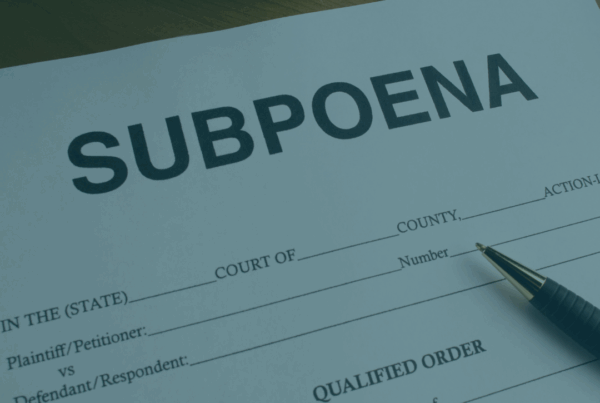Medical records are vital to any medical case. They provide a comprehensive record of a patient’s health history, diagnosis, treatment, and prognosis. Medical records impact claims, litigation, and the overall decision-making process within those actions. It is important to understand the technical aspects of medical records, become fluent with the key components relevant to legal claims and cases, and possess a healthy understanding of how to interpret records in a way that supports legal outcomes.
Why are Medical Records Important?
Medical records are essential to proving (or disproving) claims by reviewing, determining, analyzing, and assessing their role in documenting a patient’s health status, treatment history, diagnosis, and prognosis. Generally, there are 3 types of records commonly involved in legal proceedings: 1) Electronic Health Records (EHR) – often the standard and most detailed, 2) Paper Records – less common, but still in use, especially in older practices, and 3) Workers’ Compensation Records – specific to work-related injuries and treatments. These medical records are necessary in proving claims, determining the severity of the injury, linking the specific injury to a specific incident, or simply establishing a treatment timeline.
Key Components of Medical Records
Medical records are housed within various entities involved in the healthcare system (hospitals, clinics, release of information facilities, etc.). When records are requested from these facilities, they will typically be produced with several key components. Below, you will find a snapshot of some records you can expect to obtain within a set of medical records.
- Patient Information (personal details like name, date of birth, address, insurance information) that identifies the person involved in the injury.
- Medical History (includes pre-existing conditions, surgeries, medications, allergies), allowing legal professionals to decipher what conditions are pre-existing vs. new injuries.
- Diagnoses (specific health conditions diagnosed during health visits), which is crucial for establishing the nature of the injury or illness and how they relate to the legal aspects of the case.
- Treatment Plan and Notes (treatment plan and recommendations for follow-up visits) which can indicate the seriousness of the injury and assist in evaluating the extent of damages or liability in a case.
- Progress Notes (Healthcare professionals’ observations of a patient’s condition over time, including symptoms and objective findings) can help legal professionals assess whether treatment is improving or worsening a patient’s condition.
- Test/Lab Results (Test results, including lab findings, imaging reports and other diagnostic reports) can be critical in proving the existence of an injury or disease and understand its severity.
- Medical Opinions (Expert opinions or physician statements outlining prognosis, disability, and long-term impacts) can be used in litigation to determine compensation, long-term care needs, or corresponding disability claims.
- Consent Forms and Corresponding Legal Documents (forms signed by the patient giving consent for treatment, acknowledging risks, or allowing release of medical information) can be critical in determining whether consent for treatment or disclosing medical information in a legal claim or case.
Establishing and Assessing Injury Causation
Establishing causation is a key challenge in medical claims. The key legal concept revolves around whether the injury or harm was foreseeable. The concept of causation limits a defendant’s liability for negligence to consequences reasonably related to the negligent conduct. For plaintiffs, medical records can link the alleged negligent act (i.e., missed diagnosis or surgical error) to the harm the patient experienced. For example, a missed diagnosis led to a delayed diagnosis, causing additional unnecessary harm or an incorrect procedure, which led to a surgical error that caused the harm. Causation can be a difficult element to prove in medical cases. The proper medical records can make this process easier and are often essential to bridging the gap between the alleged injury and the defendant’s liability. Legal professionals can review the timeliness of symptoms and treatment and look for clear documentation that connects injuries to the specific event.
How Do Records Impact the Claim?
Medical records can either support or negate medical claims. Plaintiffs are the parties bringing the medical claim(s) and alleging the injury or harm. The patient’s medical records are vital to establishing the extent of the harm caused by the alleged medical negligence. These records can include information that can lead to errors in diagnosis, omissions to act by the medical practitioner, treatment plan, post-operative care, medications prescribed, and prognosis timelines. These items collectively are critical in proving the claim. Defendants, conversely, are the parties who are presumably liable for the injury or harm caused and are subject to the alleged claims. Medical records are vital for the defense and can show that the standard of care was followed and that the alleged injury or harm was not a result of negligence. Well-documented records can help counter allegations and demonstrate that proper care was provided.
Identifying Inconsistencies
Incomplete or inconsistent documentation within a medical record can weaken a case. For example, the patient reports pain, but there are no records supporting these claims. Another example is a doctor’s note that conflicts with test results or the patient’s statements. Furthermore, inconsistency can be identified when comparing the patient’s reported symptoms to what is documented in the progress notes or diagnostic reports. Other areas that can impact a claim include ambiguous terminology of the records and over-reliance on medical opinions.
How Medical Records Impact Different Practice Areas
Medical records significantly impact different areas of legal practice. In personal injury matters, records help establish the extent of injuries, causation, and the necessity of treatment. Medical malpractice cases use records as the primary basis of evidence for proving the standard of care and any deviation from it. In workers’ compensation matters, records validate work-related injuries or conditions. In disability claims, records determine the defendant’s competency, mental state, and nature of the injuries that serve as the basis for the claim. In insurance matters, records can support, or dispute claims made under health or life insurance. In employment law cases, records can be critical to accommodation requests, fitness for duty or discrimination claims.
Best Practices for Reviewing Medical Records
One key area for reviewing any medical records involves organizing and summarizing the records to simplify the review process. Records should be organized chronologically and cross-checked against testimonies or accident reports. Organizing the records digitally can be completed using an outsourced solution (i.e., records retrieval vendor or document management system) for electronic health records. Records can also be summarized, which simplifies the process of reviewing records, providing a clear, concise, and fact-based summary of records, presented in chronological order with hyperlinks and bookmarks for seamless navigation. This is particularly useful for records with higher page volumes.
Seeking medical expert opinions can often be crucial in proving or disproving claims. It can be advantageous to consult with medical experts to provide an opinion regarding complex situations or claims to correctly interpret the medical records more effectively. This assessment can be used to support legal arguments in litigation.
Finally, requesting additional records can be valuable, especially when additional healthcare providers are identified in the records or if the patient continued treatment during the claim evaluation. Requesting and obtaining records from all healthcare providers involved in the case ensures the accuracy and comprehensiveness of the records.
It is very important to keep detailed notes on significant findings within the medical records, which could influence the outcome of a case.
Summary
Reading, analyzing, and utilizing medical records is crucial in legal cases; legal professionals can leverage these records to support or negate injury claims. It is essential to evaluate your current process for managing medical records in your current caseload. Setting forth best practices to help you achieve your desired outcomes is critical in claim and case management. Being proactive in reviewing medical records thoroughly and consulting with medical experts when needed often is the edge needed to succeed in alleging or negating claims. By establishing efficient systems and incorporating expert insight, legal professionals can strengthen their case strategies and ultimately ensure more accurate, reliable outcomes in legal proceedings.







